 I was a bit reluctant with this at first, mainly because this album is like 80% George Harrison, but GH was the true talent of the Beatles, so I guess if you’re gonna cover songs of one of the fab four, his make the most sense. God forbid she chose Ringo…. Somehow, I feel a 20 minute version of “Octopus’s Garden” wouldn’t hold the same potency as the belting gospel driven take on “My Sweet Lord”. For me though, it’s her take on “Isn’t It a Pity” that does it for me. This song is Nina Simone at the absolute height of her soul powers. Beautiful subtle vamping, super subtle bass for the melody to glide along, and her sublime warm and heartfelt, half spoken, half sung vocals. You really won’t find many tunes that melt the heart like her take on this one. –Ben
I was a bit reluctant with this at first, mainly because this album is like 80% George Harrison, but GH was the true talent of the Beatles, so I guess if you’re gonna cover songs of one of the fab four, his make the most sense. God forbid she chose Ringo…. Somehow, I feel a 20 minute version of “Octopus’s Garden” wouldn’t hold the same potency as the belting gospel driven take on “My Sweet Lord”. For me though, it’s her take on “Isn’t It a Pity” that does it for me. This song is Nina Simone at the absolute height of her soul powers. Beautiful subtle vamping, super subtle bass for the melody to glide along, and her sublime warm and heartfelt, half spoken, half sung vocals. You really won’t find many tunes that melt the heart like her take on this one. –Ben
Jive Time Turntable
Billy Nichols “Would You Believe” (1968)
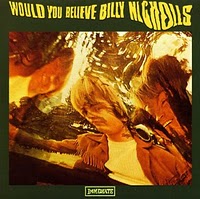 “Would You Believe” is stunning late ’60’s pop crafted with knowing nods of love to Brian Wilson’s Pet Sounds, that thankfully NEVER forgets the importance of the… (cough) London Social Degree. However, if drug references are Billy’s point, they’re overwhelmed soniclly as “Would You…” is packed full of LUSH, dense arrangements awash with a “sound” that serves to unify the LP as a whole… it’s absolutely gorgeous. In fact… I own two copies (I wish!). Anyways, turns out, thirty years ago, this LP was shelved without any believable reason, the Loog, the fella responsible for the shelving, oughta be ashamed. –Nipper
“Would You Believe” is stunning late ’60’s pop crafted with knowing nods of love to Brian Wilson’s Pet Sounds, that thankfully NEVER forgets the importance of the… (cough) London Social Degree. However, if drug references are Billy’s point, they’re overwhelmed soniclly as “Would You…” is packed full of LUSH, dense arrangements awash with a “sound” that serves to unify the LP as a whole… it’s absolutely gorgeous. In fact… I own two copies (I wish!). Anyways, turns out, thirty years ago, this LP was shelved without any believable reason, the Loog, the fella responsible for the shelving, oughta be ashamed. –Nipper
Fripp & Eno “Evening Star” (1975)
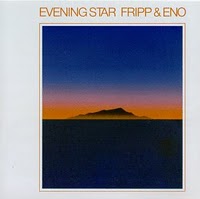 The second collaboration between the two highbrow British art/prog rockers, Evening Star pairs Fripp’s “Frippertronic” guitar, layered and sustained indefinitely through use of analog tape loops, with synthesizer and various treatments from Eno, for an ambient match made in heaven. The serene first side is highlighted by the beautiful title track, which borders on melodic, while still maintaining the minimalist style of Eno’s ambient works. Conversely, the second side, titled “An Index of Metals,” quietly builds layers of ever more dissonant guitar, developing an unnerving atmosphere. This is an album that effortlessly creates a distinctly reflective mood, and is an essential item for fans of either artist. –Ben
The second collaboration between the two highbrow British art/prog rockers, Evening Star pairs Fripp’s “Frippertronic” guitar, layered and sustained indefinitely through use of analog tape loops, with synthesizer and various treatments from Eno, for an ambient match made in heaven. The serene first side is highlighted by the beautiful title track, which borders on melodic, while still maintaining the minimalist style of Eno’s ambient works. Conversely, the second side, titled “An Index of Metals,” quietly builds layers of ever more dissonant guitar, developing an unnerving atmosphere. This is an album that effortlessly creates a distinctly reflective mood, and is an essential item for fans of either artist. –Ben
The Baby Huey Story “The Living Legend” (1971)
 The posthumously released “The Living Legend” is solid, melodic, slightly psychedelic, catchy funk from top to bottom. In fact, it rocks surprisingly hard, with more than a little Sly Stone influence. Curtis Mayfield gets the production credit here, and this has got to be the most rocking thing he was ever involved in. Now, Baby Huey is no great singer, but he is “400 pounds of soul.” What he lacks in technical ability, he more than makes up for in delivery and personality. His sermon during “A Change is Going to Come” doesn’t make a hell of a lot of sense, but it sure sounds good. Ditto for his ramblings on Mayfield’s “Mighty Mighty,” which didn’t fair too well on the singles charts, but may be one of the most chaotic, fun sounding recordings ever released as such – sorta like the Beach Boys “Barbara Ann” on acid. It, along with the rest of the album, really give you the sense that these guys must have been a ton of fun (literally) in concert. The standout tracks are most likely “Hard Times,” with its instantly recognizable, oft-sampled intro; and “Running,” which could be the most exciting, hardest rocking track on the whole album. –DL
The posthumously released “The Living Legend” is solid, melodic, slightly psychedelic, catchy funk from top to bottom. In fact, it rocks surprisingly hard, with more than a little Sly Stone influence. Curtis Mayfield gets the production credit here, and this has got to be the most rocking thing he was ever involved in. Now, Baby Huey is no great singer, but he is “400 pounds of soul.” What he lacks in technical ability, he more than makes up for in delivery and personality. His sermon during “A Change is Going to Come” doesn’t make a hell of a lot of sense, but it sure sounds good. Ditto for his ramblings on Mayfield’s “Mighty Mighty,” which didn’t fair too well on the singles charts, but may be one of the most chaotic, fun sounding recordings ever released as such – sorta like the Beach Boys “Barbara Ann” on acid. It, along with the rest of the album, really give you the sense that these guys must have been a ton of fun (literally) in concert. The standout tracks are most likely “Hard Times,” with its instantly recognizable, oft-sampled intro; and “Running,” which could be the most exciting, hardest rocking track on the whole album. –DL
Wayne Shorter “Juju” (1964)
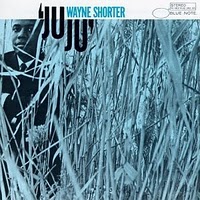 Modal jazz meets brilliant songwriting on this unbelievably strong effort from a young Wayne Shorter. Abstract at first, but completely catchy and whistleable after a listen or two, there’s just a sort of magic that happens when you combine this blend of otherworldly experimentation and clever, nearly pop blues-based hooks. Songs like “Deluge” and “Mahjong” play around with a theme just long enough to make you forget it, and then bring it back like a chorus. “Twelve More Bars To Go” is bright and airy blues in a familiar format, but the interplay and abstraction allow the soloists to wander away from the structure, to test the waters, and then return comfortably. Shorter’s tone is fantastic, his lines are lyrical, he along with the band creates a light and spacious mood that is bluesy, relaxed and on occasion serious, but is always engaging. The back-and-forth between he and McCoy Tyner is sublime, and the tempos are bouncy and spry without being pushy or demanding. Drummer Elvin Jones is at the top of his game, really showing some amazing soft-handed speed on the title track. All in all, a perfect post-bop record. –Cameron
Modal jazz meets brilliant songwriting on this unbelievably strong effort from a young Wayne Shorter. Abstract at first, but completely catchy and whistleable after a listen or two, there’s just a sort of magic that happens when you combine this blend of otherworldly experimentation and clever, nearly pop blues-based hooks. Songs like “Deluge” and “Mahjong” play around with a theme just long enough to make you forget it, and then bring it back like a chorus. “Twelve More Bars To Go” is bright and airy blues in a familiar format, but the interplay and abstraction allow the soloists to wander away from the structure, to test the waters, and then return comfortably. Shorter’s tone is fantastic, his lines are lyrical, he along with the band creates a light and spacious mood that is bluesy, relaxed and on occasion serious, but is always engaging. The back-and-forth between he and McCoy Tyner is sublime, and the tempos are bouncy and spry without being pushy or demanding. Drummer Elvin Jones is at the top of his game, really showing some amazing soft-handed speed on the title track. All in all, a perfect post-bop record. –Cameron
This Heat “Deceit” (1981)
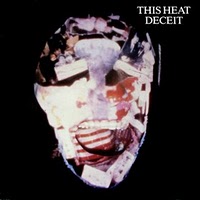 Stimulus and response. Art rock on the far side of punk, this is as nervously exposed and at least as aggressive as the latter, while being as meticulously constructed and self-reflective as the former. The essential difference is in the aesthetic commitment. They rehearsed and composed in a meat locker, and being committed to their conceptions, they recorded their records there too. The paradox of making such vital music in such a moribund space comes to a strangely logical fulfillment by being this album’s greatest sonic virtue: its shock and awe dynamics forego the simple attack of a studio-made record which would appeal to more ears and be both more prog and more punk. This is rock as art and thus no audience. Too bad we choose categories over impulses. On the other hand, they’re now gaining ground, and, unfortunately, wider influence. Commodification is coming. Enjoy the impact of this record while it lasts.
Stimulus and response. Art rock on the far side of punk, this is as nervously exposed and at least as aggressive as the latter, while being as meticulously constructed and self-reflective as the former. The essential difference is in the aesthetic commitment. They rehearsed and composed in a meat locker, and being committed to their conceptions, they recorded their records there too. The paradox of making such vital music in such a moribund space comes to a strangely logical fulfillment by being this album’s greatest sonic virtue: its shock and awe dynamics forego the simple attack of a studio-made record which would appeal to more ears and be both more prog and more punk. This is rock as art and thus no audience. Too bad we choose categories over impulses. On the other hand, they’re now gaining ground, and, unfortunately, wider influence. Commodification is coming. Enjoy the impact of this record while it lasts.
History repeats itself. But good music never does. This is the best-kept secret in rock music. So essential, this review ain’t worth the bytes it’s made of. Just get it already. (No, don’t!) –Will
Funkadelic “Let’s Take it to the Stage” (1975)
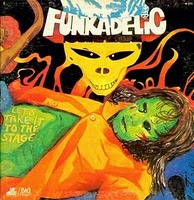 Let’s Take it to the Stage is easily a top-3 Funkadelic album, maybe even the best. It opens with the rocking one-two punch of “Good to Your Earhole” and “Better by the Pound”. I’ve always considered Funkadelic a rock band that is extremely funky, not vice versa, and these two tracks add credence to that way of thinking. Next is “Be My Beach” which is one of the most unique, trippy songs they have ever made. Bootsy’s vocals are fantastic. Fourth is Clinton’s updated take on Sly and the Family Stone’s “Jane is a Groupie”. “No Head, No Backstage Pass” is hilarious, sleazy, biting and to the point. It’s also on the verge of heavy metal, a concept that was being invented by Black Sabbath. Next is the title track which is the biggest “hit” off of the album. Memorable for the funk mob’s playful skewering of their contemporaries, this statement of dominance doesn’t hold up as well, to me, as the wonderfully crafted tunes that surround it. One track that holds up exceedingly well, however, is “Get Off You’re Ass and Jam”. Fueled by Michael Hampton’s frenzied guitar solos, this live staple practically assaults you when you listen to it. Hampton (along with his predecessor and inspiration, Eddie Hazel) still ranks among rock’s greatest guitarists, and his performance on this album is one of the reasons why.
Let’s Take it to the Stage is easily a top-3 Funkadelic album, maybe even the best. It opens with the rocking one-two punch of “Good to Your Earhole” and “Better by the Pound”. I’ve always considered Funkadelic a rock band that is extremely funky, not vice versa, and these two tracks add credence to that way of thinking. Next is “Be My Beach” which is one of the most unique, trippy songs they have ever made. Bootsy’s vocals are fantastic. Fourth is Clinton’s updated take on Sly and the Family Stone’s “Jane is a Groupie”. “No Head, No Backstage Pass” is hilarious, sleazy, biting and to the point. It’s also on the verge of heavy metal, a concept that was being invented by Black Sabbath. Next is the title track which is the biggest “hit” off of the album. Memorable for the funk mob’s playful skewering of their contemporaries, this statement of dominance doesn’t hold up as well, to me, as the wonderfully crafted tunes that surround it. One track that holds up exceedingly well, however, is “Get Off You’re Ass and Jam”. Fueled by Michael Hampton’s frenzied guitar solos, this live staple practically assaults you when you listen to it. Hampton (along with his predecessor and inspiration, Eddie Hazel) still ranks among rock’s greatest guitarists, and his performance on this album is one of the reasons why.
While Let’s Take it to the Stage doesn’t get the recognition of Maggot Brain or One Nation Under a Groove, it is every bit as essential. Clinton and company were at a song-writing apex, giving us several 2-5 minute blasts of brilliance. The assertion that Funkadelic is the “black Beatles” is not far off base. Strip away the psychedelia, the dark humor, the monstrous bass of Bootsy and the general Funkadelic craziness, and you’ve got a perfectly crafted pop album. Of course, strip all of that away, and you don’t have Funkadelic. –Lucas
The Records “The Records” (1979)
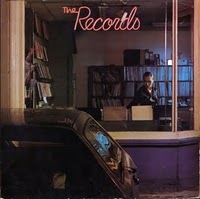 Sure, their flawless, jet-setting single “Starry Eyes” is reason enough to pick up The Records’ debut, but the album as a whole is stuffed with more sugary goodness than your average box of Frosted Flakes. The first side is jam-packed with the restless “All Messed Up and Ready to Go,” adolescent buzz of “Teenarama,” minor key mood piece “Girls That Don’t Exist,” and choice deep cut in the lingering ballad “Up All Night,” while the remainder is highlighted by the punchy rock of “Girl,” nervous “Insomnia,” and jukebox hero tale, “Another Star.” With the requisite vocal harmonies and ringing guitars filled out with the occasional organ or synthesizer, The Records is steadfast in it’s delivery of classic power pop confection. –Ben
Sure, their flawless, jet-setting single “Starry Eyes” is reason enough to pick up The Records’ debut, but the album as a whole is stuffed with more sugary goodness than your average box of Frosted Flakes. The first side is jam-packed with the restless “All Messed Up and Ready to Go,” adolescent buzz of “Teenarama,” minor key mood piece “Girls That Don’t Exist,” and choice deep cut in the lingering ballad “Up All Night,” while the remainder is highlighted by the punchy rock of “Girl,” nervous “Insomnia,” and jukebox hero tale, “Another Star.” With the requisite vocal harmonies and ringing guitars filled out with the occasional organ or synthesizer, The Records is steadfast in it’s delivery of classic power pop confection. –Ben
The Fall “Live at the Witch Trials” (1979)
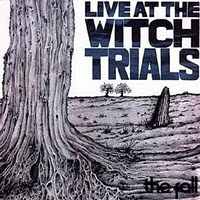 They are the Fall. He is the Fall. I’m awfully glad someone is, because, pound for pound, album for album, song for song, no one would make such consistently exciting music between 1977 and about 1987. Their debut LP is just about as extraordinary as any of their other prime-period albums, as a young Mark E Smith rants over a busily neurotic minimalism that here sounds a lot like Public Image Ltd. but with more Can than dub in the mix. They also have more studio polish here than they would for several albums, even if it is an ultra-cheap studio sound with a slightly cheesy “punchy” drum sound and a rather drab mix that’s oddly glossy in comparison with, say, Grotesque or Hex Enduction Hour. And even if the infamous Fall sonic/conceptual vocabulary is only in its infancy on this one, this is light years ahead of its peers for morbidly funny, scathing misanthropic vitriol and irresistible two-note hooks. I shouldn’t say that. The Fall have always been peerless. Not a weak track on here; threatening, hilarious, creepy, that is the Fall. If you don’t like ’em, you deserve it. –Will
They are the Fall. He is the Fall. I’m awfully glad someone is, because, pound for pound, album for album, song for song, no one would make such consistently exciting music between 1977 and about 1987. Their debut LP is just about as extraordinary as any of their other prime-period albums, as a young Mark E Smith rants over a busily neurotic minimalism that here sounds a lot like Public Image Ltd. but with more Can than dub in the mix. They also have more studio polish here than they would for several albums, even if it is an ultra-cheap studio sound with a slightly cheesy “punchy” drum sound and a rather drab mix that’s oddly glossy in comparison with, say, Grotesque or Hex Enduction Hour. And even if the infamous Fall sonic/conceptual vocabulary is only in its infancy on this one, this is light years ahead of its peers for morbidly funny, scathing misanthropic vitriol and irresistible two-note hooks. I shouldn’t say that. The Fall have always been peerless. Not a weak track on here; threatening, hilarious, creepy, that is the Fall. If you don’t like ’em, you deserve it. –Will
Oscar Toney, Jr. “For Your Precious Love” (1967)
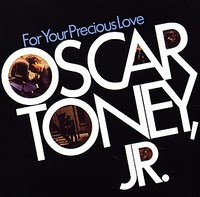 Lordy, I’m a sucker for Deep Soul. You know the weepy, hollering gospel driven soul, which reaches through you and twists and pulls and pulls and twists on your heart till every last drop of feeling bad and blue, even if you have nothing feel bad about…spills over and drips down your face. Yeah…it is that feeling which Oscar nails! That said, Toney’s “Precious Love” LP is a solid chin wiggling and tear jerking event, but…there’s a song or two which crosses over into “classy pop”. But please don’t be afraid of strings, Toney is not given to schmaltzy “Warwick” pop/soul…oh, and there’s even, at least, one Northern mover…thankfully, which gives me time between weepers to dance over to a fresh box of tissues. –Nipper
Lordy, I’m a sucker for Deep Soul. You know the weepy, hollering gospel driven soul, which reaches through you and twists and pulls and pulls and twists on your heart till every last drop of feeling bad and blue, even if you have nothing feel bad about…spills over and drips down your face. Yeah…it is that feeling which Oscar nails! That said, Toney’s “Precious Love” LP is a solid chin wiggling and tear jerking event, but…there’s a song or two which crosses over into “classy pop”. But please don’t be afraid of strings, Toney is not given to schmaltzy “Warwick” pop/soul…oh, and there’s even, at least, one Northern mover…thankfully, which gives me time between weepers to dance over to a fresh box of tissues. –Nipper
Black Sabbath “Master of Reality” (1971)
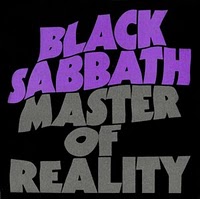 The beautiful thing thing about the first few Black Sabbath records is that, although they’re the heaviest, darkest, and most extreme representations of electric guitar driven music at that time, it’s the kind of thing a five year old could get down to at first listen. Their undeniably satisfying grooves, hooks, and drive leave them sounding as easily digestible as Creedence Clearwater Revival, only dipped in wax and plugged through a marshall stack in the dark. Master Of Reality, Sabbath’s third testament, is probably their darkest. From the black haze of a cover and heaviest album title of all time, to guitar tone that sounds like the amps took bong rips, the record has enough vibe to spook a horse. The songs are laid back and seem to exercise groove endurance, giving the effect of psychedelia through hypnotism. Juxtaposing the fuzz are two short mellow instrumentals and the angelic “solitude,” which sounds like a candle glowing under the ocean. Art of the highest order and accessible to all walks. if you haven’t yet gotten down, I suggest getting down immediately. -Alex
The beautiful thing thing about the first few Black Sabbath records is that, although they’re the heaviest, darkest, and most extreme representations of electric guitar driven music at that time, it’s the kind of thing a five year old could get down to at first listen. Their undeniably satisfying grooves, hooks, and drive leave them sounding as easily digestible as Creedence Clearwater Revival, only dipped in wax and plugged through a marshall stack in the dark. Master Of Reality, Sabbath’s third testament, is probably their darkest. From the black haze of a cover and heaviest album title of all time, to guitar tone that sounds like the amps took bong rips, the record has enough vibe to spook a horse. The songs are laid back and seem to exercise groove endurance, giving the effect of psychedelia through hypnotism. Juxtaposing the fuzz are two short mellow instrumentals and the angelic “solitude,” which sounds like a candle glowing under the ocean. Art of the highest order and accessible to all walks. if you haven’t yet gotten down, I suggest getting down immediately. -Alex
Curtis Mayfield “Superfly” (1972)
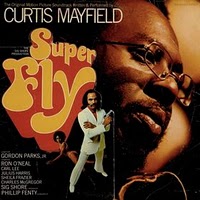 A monument of 70’s soul music that totally eclipsed the film it scores and for good reason as an average film continues to get a lot of attention on the back of this record. While the film seemed to glamorize drug dealing in the black community Curtis told the real and much less appealing truth about his communities struggle against its evils. In doing so he produced a record of real power and one with a bittersweet feel as serious and depressing subject matter is delivered by the delicate almost angelic falsetto. It is up there with the great soul concept LP’s like Marvin Gaye’s “What’s Going On” and Donny Hathaway’s “Extension of a Man” that signaled a major shift in the power of soul and black music in general. –Jon
A monument of 70’s soul music that totally eclipsed the film it scores and for good reason as an average film continues to get a lot of attention on the back of this record. While the film seemed to glamorize drug dealing in the black community Curtis told the real and much less appealing truth about his communities struggle against its evils. In doing so he produced a record of real power and one with a bittersweet feel as serious and depressing subject matter is delivered by the delicate almost angelic falsetto. It is up there with the great soul concept LP’s like Marvin Gaye’s “What’s Going On” and Donny Hathaway’s “Extension of a Man” that signaled a major shift in the power of soul and black music in general. –Jon


